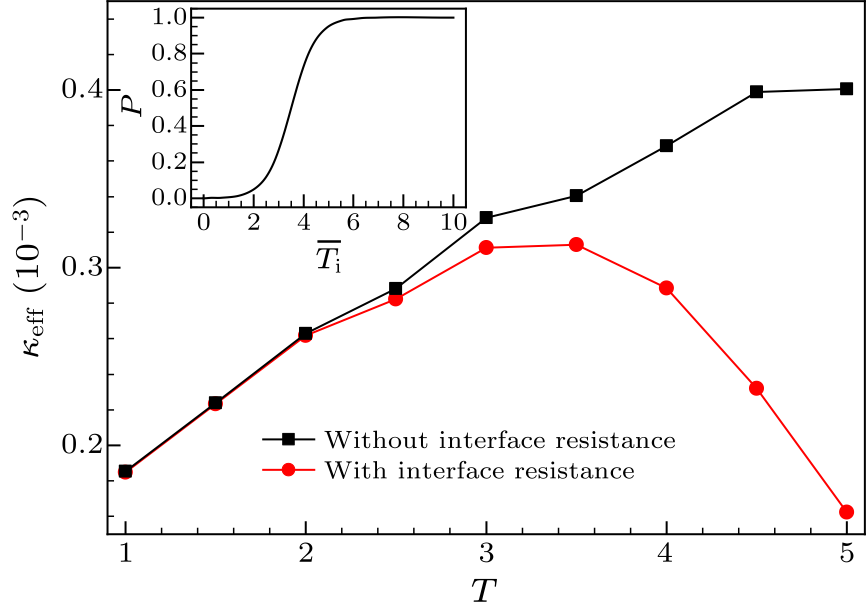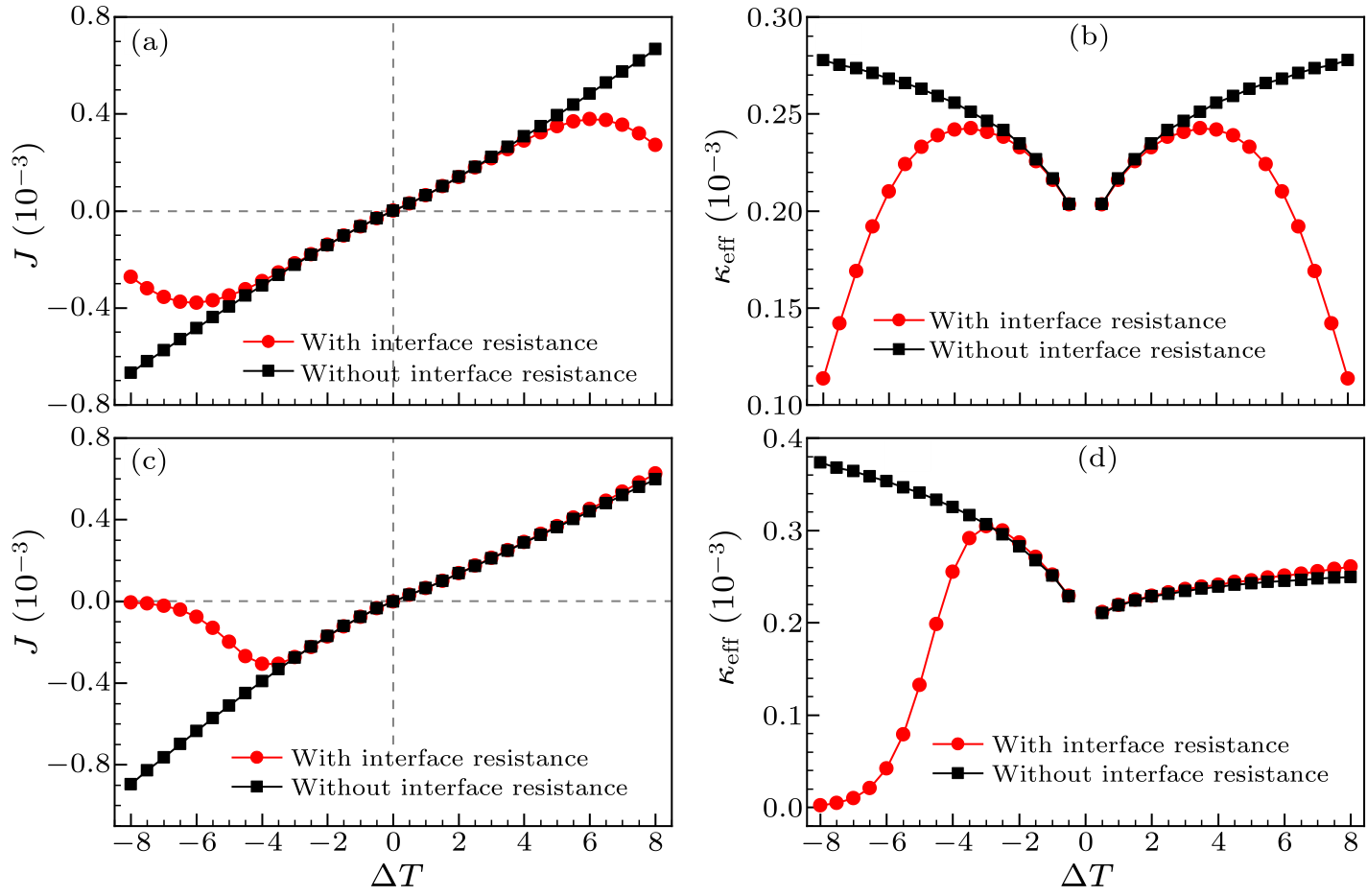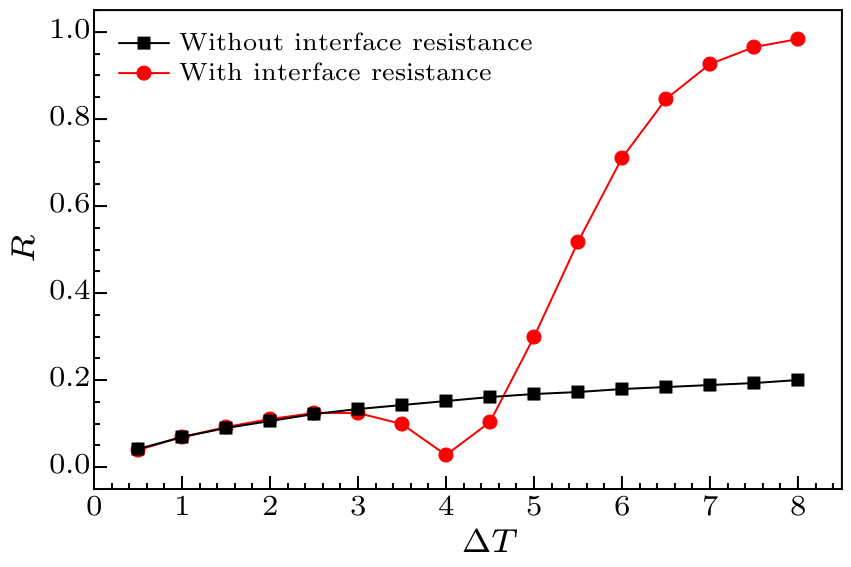
Fig. 1. (a) Schematic diagram of the macroscopic homojunction/heterojunction thermal transport model. (b) and (c) Schematic diagram of the modified Lorentz gas model for homojunction and heterojunction. The model space is a rectangle of total length $L$ and width $D$, and static circular scattering media having a radius $R$ are arranged internally (totally $N$: $n_x$ rows, $n_y$ columns). The setting of the model in (a) and (b) is as follows: $L=200$, $D=60$, $n_x=3$, $n_y=10$, $R_{\rm R}=6$, $R_{\rm L}=6(2)$. The green area between the dashed lines indicates the interface area. (c) Temperature distribution along the transmission direction with different interface reflection probabilities, where $T_{\rm L}=1$, $T_{\rm R}=9$. The temperature is approximately linearly distributed in the material. (d) The interface temperature jump as a function of the interface reflection probability. In the inset, we give the relationship between the external temperature difference and the interface temperature jump in a constant interface reflection probability ($P=0.8$).

Fig. 2. The effective thermal conductivity of homojunction is a function of the model temperature. The temperature setting of thermal source is as follows: $T_{\rm L}=T+dT$, $T_{\rm R}=T-dT$, $dT=0.1$. In the figure, red (black) represents the case with (without) the interface thermal resistance. The relationship between the interface reflection probability and the average interface temperature is shown in the inset.

Fig. 3. (a) and (c) Thermal flow is a function of the external temperature difference for homojunction and heterojunction. (b) and (d) The effective thermal conductivity is a function of the external temperature difference for homojunction and heterojunction. The red and black lines represent the cases with and without the interface thermal resistance, respectively. The thermal source temperature at both ends of the material is set to $T_{\rm L}=1$ ($T_{\rm R}=1$) and $T_{\rm R}=1+\Delta T$ ($T_{\rm L}=1+\Delta T$) when $\Delta T > 0$ ($\Delta T < 0$).

Fig. 4. Thermal rectification factor is a function of the external temperature difference for the heterojunction model. The red and black lines represent the cases with and without the interface thermal resistance, respectively.
| [1] | Terraneo M, Peyrard M and Casati G 2002 Phys. Rev. Lett. 88 094302 | Controlling the Energy Flow in Nonlinear Lattices: A Model for a Thermal Rectifier
| [2] | Li B, Wang L and Casati G 2004 Phys. Rev. Lett. 93 184301 | Thermal Diode: Rectification of Heat Flux
| [3] | Li B, Lan J and Wang L 2005 Phys. Rev. Lett. 95 104302 | Interface Thermal Resistance between Dissimilar Anharmonic Lattices
| [4] | Yang Y, Chen H, Wang H, Li N and Zhang L 2018 Phys. Rev. E 98 042131 | Optimal thermal rectification of heterojunctions under Fourier law
| [5] | Wang H, Yang Y, Chen H, Li N and Zhang L 2019 Phys. Rev. E 99 062111 | Thermal rectification induced by geometrical asymmetry: A two-dimensional multiparticle Lorentz gas model
| [6] | Jiang P, Hu S, Ouyang Y, Ren W, Yu C, Zhang Z and Chen J 2020 J. Appl. Phys. 127 235101 | Remarkable thermal rectification in pristine and symmetric monolayer graphene enabled by asymmetric thermal contact
| [7] | Zhang Z, Ouyang Y, Cheng Y, Chen J, Li N and Zhang G 2020 Phys. Rep. 860 1 | Size-dependent phononic thermal transport in low-dimensional nanomaterials
| [8] | Strohm C, Rikken G L J A and Wyder P 2005 Phys. Rev. Lett. 95 155901 | Phenomenological Evidence for the Phonon Hall Effect
| [9] | Zhang L, Wang J and Li B 2009 New J. Phys. 11 113038 | Phonon Hall effect in four-terminal nano-junctions
| [10] | Zhang L 2016 New J. Phys. 18 103039 | Berry curvature and various thermal Hall effects
| [11] | Li B, Wang L and Casati G 2006 Appl. Phys. Lett. 88 143501 | Negative differential thermal resistance and thermal transistor
| [12] | He D, Buyukdagli S and Hu B 2009 Phys. Rev. B 80 104302 | Origin of negative differential thermal resistance in a chain of two weakly coupled nonlinear lattices
| [13] | Hu J, Wang Y, Vallabhaneni A, Ruan X and Chen Y 2011 Appl. Phys. Lett. 99 113101 | Nonlinear thermal transport and negative differential thermal conductance in graphene nanoribbons
| [14] | Joulain K, Drevillon J, Ezzahri Y and Ordonez-Miranda J 2016 Phys. Rev. Lett. 116 200601 | Quantum Thermal Transistor
| [15] | Fornieri A, Timossi G, Bosisio R, Solinas P and Giazotto F 2016 Phys. Rev. B 93 134508 | Negative differential thermal conductance and heat amplification in superconducting hybrid devices
| [16] | Criado-Sancho M and Jou D 2017 J. Appl. Phys. 121 024503 | A simple model of thermoelastic heat switches and heat transistors
| [17] | Yang Y, Ma D, Zhao Y and Zhang L 2020 J. Appl. Phys. 127 195301 | Negative differential thermal resistance effect in a macroscopic homojunction
| [18] | Chang C, Okawa D, Majumdar A and Zettl A 2006 Science 314 1121 | Solid-State Thermal Rectifier
| [19] | Wang H, Hu S, Takahashi K, Zhang X, Takamatsu H and Chen J 2017 Nat. Commun. 8 1 | In situ click chemistry generation of cyclooxygenase-2 inhibitors
| [20] | Pollack G 1969 Rev. Mod. Phys. 41 48 | Kapitza Resistance
| [21] | Swartz E and Pohl R 1989 Rev. Mod. Phys. 61 605 | Thermal boundary resistance
| [22] | Swartz E and Pohl R 1987 Appl. Phys. Lett. 51 2200 | Thermal resistance at interfaces
| [23] | Stoner R and Maris H 1993 Phys. Rev. B 48 16373 | Kapitza conductance and heat flow between solids at temperatures from 50 to 300 K
| [24] | Costescu R, Wall M and Cahill D 2003 Phys. Rev. B 67 054302 | Thermal conductance of epitaxial interfaces
| [25] | Lyeo H and Cahill D 2006 Phys. Rev. B 73 144301 | Thermal conductance of interfaces between highly dissimilar materials
| [26] | Chen Z, Jang W, Bao W, Lau C and Dames C 2009 Appl. Phys. Lett. 95 161910 | Thermal contact resistance between graphene and silicon dioxide
| [27] | Landry E and Mcgaughey A 2009 Phys. Rev. B 80 165304 | Thermal boundary resistance predictions from molecular dynamics simulations and theoretical calculations
| [28] | Koh Y, Bae M, Cahill D and Pop E 2010 Nano Lett. 10 4363 | Heat Conduction across Monolayer and Few-Layer Graphenes
| [29] | Ye N, Feser J, Sadasivam S, Fisher T, Wang T, Ni C and Janotti A 2017 Phys. Rev. B 95 085430 | Thermal transport across metal silicide-silicon interfaces: An experimental comparison between epitaxial and nonepitaxial interfaces
| [30] | Hohensee G, Wilson R and Cahill D 2015 Nat. Commun. 6 6578 | Thermal conductance of metal–diamond interfaces at high pressure
| [31] | Hsieh W, Lyons A, Pop E, Keblinski P and Cahill D 2011 Phys. Rev. B 84 184107 | Pressure tuning of the thermal conductance of weak interfaces
| [32] | Alonso D, Artuso R, Casati G and Guarneri I 1999 Phys. Rev. Lett. 82 1859 | Heat Conductivity and Dynamical Instability
| [33] | Li B, Casati G and Wang J 2003 Phys. Rev. E 67 021204 | Heat conductivity in linear mixing systems
| [34] | Larralde H, Leyvraz F and Mejia-Monasterio C 2003 J. Stat. Phys. 113 197 | Transport Properties of a Modified Lorentz Gas
| [35] | Casati G, Mejia-Monasterio C and Prosen T 2007 Phys. Rev. Lett. 98 104302 | Magnetically Induced Thermal Rectification
| [36] | Chen H, Wang H, Yang Y, Li N and Zhang L 2018 Phys. Rev. E 98 032131 | Rough boundary effect in thermal transport: A Lorentz gas model
| [37] | Chen H, Yang Y, Yu Z, Zhong M and Zhang L 2020 Phys. Rev. E 101 042129 | Thermal Hall effect from a modified Lorentz gas model
| [38] | Hao Q, Chen G and Jeng M 2009 J. Appl. Phys. 106 114321 | Frequency-dependent Monte Carlo simulations of phonon transport in two-dimensional porous silicon with aligned pores
| [39] | Hori T, Shiomi J and Dames C 2015 Appl. Phys. Lett. 106 171901 | Effective phonon mean free path in polycrystalline nanostructures